

Sea Launch. The sea-based launch system means the rockets can be fired from the optimum position on Earth's surface, considerably increasing payload capacity and reducing launch costs[1] compared to land-based systems.

Space Services Inc. - Name A Star Space Launch: a unique and meaningful gift. Space Services Inc. Space Services, Inc. of America is a space services company that provides star naming services as well as space memorial services through its subsidiary company, Celestis. [1] Though today it buys secondary payload space on third-party commercial rockets such as Falcon I, Taurus, and Spaceloft XL, in the 1980s the company conducted test flights of several in-house rockets.
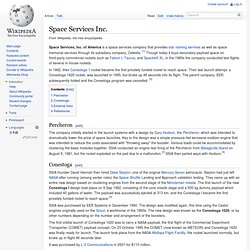
Percheron[edit] Conestoga[edit] SSIA founder David Hannah then hired Deke Slayton, one of the original Mercury Seven astronauts. Slayton had just left NASA after running (among earlier roles) the Space Shuttle Landing and Approach validation testing. They came up with an entire new design based on clustering engines from the second stage of the Minuteman missile. The first orbital launch of Conestoga 1620 was to carry a NASA payload, the first flight of the Commercial Experiment Transporter (COMET) payload concept. It was purchased by L-3 Communications in 2001 for $110 million. Rocketplane Global, Inc. is committed to making space, space access, and all space-related events, convenient, and affordable for space enthusiasts, travellers, adventurists, and tourists.
Rocketplane Limited, Inc. Rocketplane Limited, Inc. is a defunct aerospace design and development company headquartered in Oklahoma City, Oklahoma, with facilities in Guthrie, Oklahoma and Burns Flat, Oklahoma.

History[edit] Rocketplane Limited, Inc. was incorporated under the laws of the state of Oklahoma on 16 July 2001. The corporation’s founders envisioned building a rocketplane that would send passengers more than 330,000 feet (100 km) above the Earth. Armadillo Aerospace - Home. Welcome to Armadillo Aerospace!

Armadillo Aerospace is a leading developer of reusable rocket powered vehicles. We are focused on VTVL (vertical takeoff, vertical landing) suborbital research and passenger flights, with an eye towards eventual paths to orbit. Founded in 2000, we have an unequaled experience base with over two hundred flight tests spread over two dozen different vehicles.
We have done work for NASA and the Air Force, and flown vehicles at every X-Prize Cup event. We performed the very first flight under the new FAA/AST experimental permit regulatory regime, and we have made over two dozen more permitted flights since then, all fully insured and observed by on-site AST personnel. We believe in openness regarding both our successes and failures, and the progress updates here track our work from the very beginning. Armadillo Aerospace. Armadillo Aerospace is an aerospace startup company based in Mesquite, Texas.
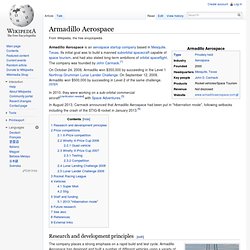
Its initial goal was to build a manned suborbital spacecraft capable of space tourism, and had also stated long-term ambitions of orbital spaceflight. COPENHAGEN SUBORBITALS - OPEN SOURCE AND NON PROFIT SPACE. Private Danish Rocket to Launch Mock Astronaut Tuesday. A private Danish rocket built by volunteers to launch one person into suborbital space is set to fly its first test flight Tuesday with a dummy pilot riding aboard.
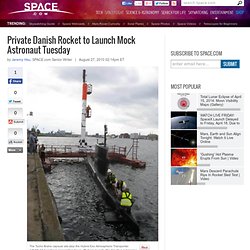
If successful, the rocket should carry its payload up almost 19 miles (30 km) into the upper atmosphere. The project could pave the way for Denmark to eventually become the fourth space-faring nation to send humans into space after Russia, the United States and China. Tuesday marks the earliest launch date within a longer launch window that stretches from Aug. 30 to Sept. 17. Danish Amateurs Launch Homemade Rocket, Aim for Future Spaceflight.
A private Danish rocket launched into the sky today (June 3) on its first successful test flight — a trip that didn't reach anywhere near space but did mark a huge step forward for the team's plan to eventually loft people on cheap suborbital spaceflights.
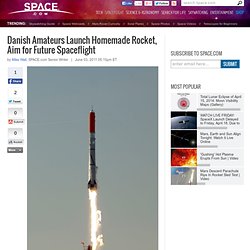
The Danish non-profit outfit Copenhagen Suborbitals launched its homemade rocket, called HEAT-1X, at about 10:30 a.m. EDT (1430 GMT) from a floating platform in the Baltic Sea. Starchaser Industries Ltd. Starchaser Industries. Starchaser Industries is a privately owned company based in the UK whose principal aim is to become a viable business in space tourism.

Formed in 1992, the company has designed and built several rocket systems - all prototypes - to investigate the feasibility of producing a space tourism vehicle. Starchaser's rocket NOVA 1, launched in 2001 from Morecambe Bay, still holds the UK record for the biggest successful rocket launch ever fired from the British mainland.[1] Since 2002, Starchaser have operated an Educational Outreach Programme that has grown steadily to become a now major aspect of the company. This arm of the company aims to take traditionally difficult and abstract areas of physics and chemistry and explain their use in rocket building. AirLaunch LLC. Falcon Small Launch Vehicle[edit] On June 14, 2006, the firm, in a DARPA sponsored test, dropped a 65,000 pounds (29 t) dummy payload from the back of a C-17, a record-setting drop for the aircraft type.[1][full citation needed] Airlaunch subsequently carried out upper stage propulsion development for the QuickReach orbital launch vehicle.
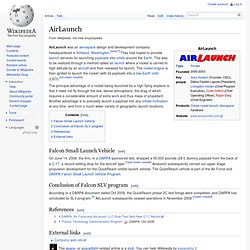
The QuickReach vehicle is part of the Air Force and DARPA Falcon Small Launch Vehicle Program. Conclusion of Falcon SLV program[edit] According to a DARPA document dated Oct 2008, the QuickReach phase 2C test firings were completed, and DARPA has concluded its SLV program.[2] AirLaunch subsequently ceased operations in November 2008. [citation needed] References[edit] External links[edit] Company web site. Starfighters, Inc. Starfighters Ready to Launch Research, Satellites. F-104 jet fighters just like the ones astronauts trained in for decades will become a more regular part of the skyscape above NASA's Kennedy Space Center as a private company expands its fleet of jets with plans to conduct more research flights, launch very small satellites into space and even take paying passengers into the stratosphere.

The developments come four years after the company made its first flight from the Shuttle Landing Facility, or SLF, at Kennedy in April 2007. Starfighters pilot and owner Rick Svetkoff is one of the new generation of entrepreneurs working to open different aspects of the aerospace world to a broader group of developers, researchers and people. "We're breaking the mold," Svetkoff said recently inside the hangar at the SLF the company leased from Space Florida. "We can go from ground to 23,000 feet as fast as some of the rockets launched here," Svetkoff said.
"High altitude and high speed is the key," Svetkoff said.